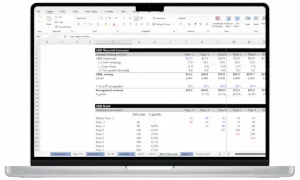What’s The Difference Between Bookings, Billings, and Revenue?
If you’re an investor or operator, you’ve probably heard the terms bookings, billings, and revenue thrown around in discussion.
You may have even used them interchangeably.
While bookings, billings, and revenue are intimately related, they represent three different phases in the revenue lifecycle. Here’s a summary:
- Bookings are promises for future revenue over the span of a contract
- Billings are promises for future revenue to be earned in the current billing period
- Revenue is income that has been earned based on services provided to date
Let’s break this down and look at each phase.
What Are Bookings in SaaS?
Bookings refer to the contract value of each individual customer contract.
For example, if you sign a new client in January for a year’s contract valued at $6,000 paid monthly, the total booking would be $6,000.
You would only bill for January’s service, but you could use the full booking value to project revenue or create an estimated budget for the rest of the year.
If the contract is for greater than 1 year, the booking value would still be the total contract value over all years of the contract.
Suppose that the client signed a 3-year contract instead of a one-year contract. Now, the total book value of the contract is $18,000, with the potential to bill and recognize $6,000 per year from the contract. If that contract also included one-time fees or add-ons not included in ARR or MRR, these amounts can still be added into the total book value of the contract.
How to Use Bookings in SaaS
Bookings are useful for revenue projections and budget planning, but they cannot be used as a guarantee of future revenue or cash flow. If the client churns or ends the contract early, the booking will disappear.
Bookings can also be used as a success metric for your sales and marketing teams. You can analyze which marketing channel or sales team brought in the most bookings. This can help you see where to focus your marketing efforts and improve sales effectiveness.
Finally, comparing bookings to revenue over time can tell you how well you are retaining customers and collecting your accounts receivable. If your actual revenue is consistently much lower than your bookings, it could indicate a problem with your churn rate, collections process, or both.
On the other hand, bookings are not particularly useful when comparing one customer contract value to another, as they do not account for the length of the contract. If you want to derive annual contract values from multi-year bookings, you will need to convert them to an annual figure.
What Are Billings in SaaS?
Billings are the current amount of the contract for the period.
Take the contract from our example. The booked value of the contract for the year is $6,000. Assuming the contract is paid monthly, in the first month, $500 of the contract will be billed to the customer.
Now the contract looks like this:
Book value: $18,000 (lifetime) or $6,000 (annual)
Billings: $500
The billing is for work done or service performed during the billing period. This is still not the same as revenue, but it is closer to “guaranteed” than a booking.
Revenue is not recognized until earned, or when the contract performance obligation for the period has been satisfied.
However, since the customer has been billed, it will be listed in accounts receivable and can usually be counted on as future revenue.
How to Use Billings in SaaS
Billings alone are not a very useful metric on their own.
But, in some situations, what they can highlight is that the company is having trouble converting contracts into actual cash flow. That’s because if the company has lots of billings, but is not leading to actual cash collection, it can show that the company is having issues with cash collection or bad debts with customers.

- 33 lessons
- 8+ video hours
- Excels & templates
What Is Revenue In SaaS?
Revenue is money actually earned from customers.
It is not the same as a cash receipt. Revenue is a mark that the company has actually fulfilled the contract performance obligation for the period, and has earned the billed amount.
Our example company has moved on from January to February in its contract, and the contract now looks like this:
Booked: $5,000
Billed: $500 for January, $500 for February
Revenue: $500 for January
The accrual method is the industry accounting standard for SaaS companies (and all companies), and it ties in well with the bookings, billings, and revenue cycle.
Since accrual accounting recognizes revenue as it is earned and not necessarily as it is received, you will need to allow for this when creating your budget.
The cash budget will look different than the income projections for the month, as cash is usually received in the next month after the revenue is received.
How Do Bookings Convert To Revenue?
To put it simply, bookings convert to revenue through excellent customer retention and cash collection.
Each phase of the revenue cycle, from bookings to billings to revenue, is a chance for a customer to churn or fail to pay.
The total contract value will flow from the very first day the customer signs the contract, through each period’s billing and revenue recognition, to the end of the contract when all of the original contract booking will have been recognized as revenue.
Of course, some of the bookings will churn. Other contracts will have add-on bookings added during the life of the contract, increasing the total contract value and customer lifetime value. Initial contract bookings are merely an estimate of the revenue over the total life of the contract.
Once you have converted your bookings to revenue, you have a solid picture of the finances of your company. This is the number on the financial statement that you can “take to the bank” – quite literally – or to private equity investors.
Understanding the difference between bookings and final revenue is like seeing the difference between a budgeted income statement at the beginning of the period and seeing how the quarter actually turned out after it is over. You get to see what estimates were accurate, which ones fell short, and what metrics turned out better than expected.
Revenue To Cash
A discussion of revenue would not be complete without a word on cash collections. Revenue on the income statement is great and can lead to further investment and growth opportunities, but it won’t pay the bills.
The final step in the cycle is, of course, the conversion of the billed amounts in accounts receivable to cash. Depending on your company’s payment terms, you may find yourself recognizing revenue and issuing bills to customers in one period, and receiving the cash in the next.
It is important to keep an eye on the difference between your revenue and your cash collections to ensure that they tie closely. If there is too much time between revenue recognition and cash receipt, you may encounter awkward cash shortfalls.
Companies should keep an eye on your cash flow and adjust collection policies as necessary. Too-generous payment terms may lead customers to take advantage.
This is why investors and banks need to see a cash flow statement alongside an income statement.
The cash flow statement tells how well you are able to manage your revenue. Comparing the cash flow statement to the income statement will show how much of your revenue you collect in cash, how long it takes for you to collect it, and how well you will be able to meet your current financial obligations with the revenue and cash levels you have.
Next Steps
To go even deeper, check out my online course on SaaS Metrics and Financial Modeling.


 SaaS & Growth Metrics
SaaS & Growth Metrics Break Into Growth Equity
Break Into Growth Equity
